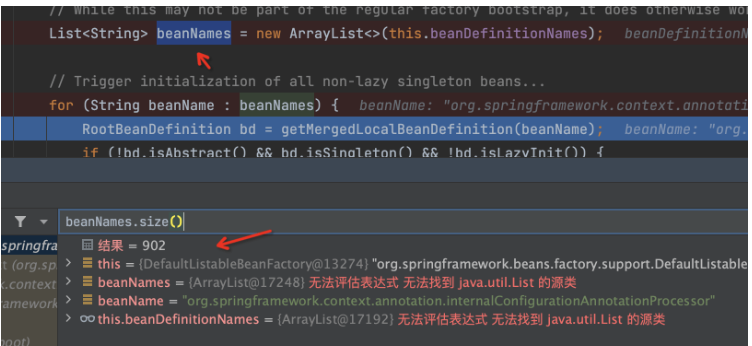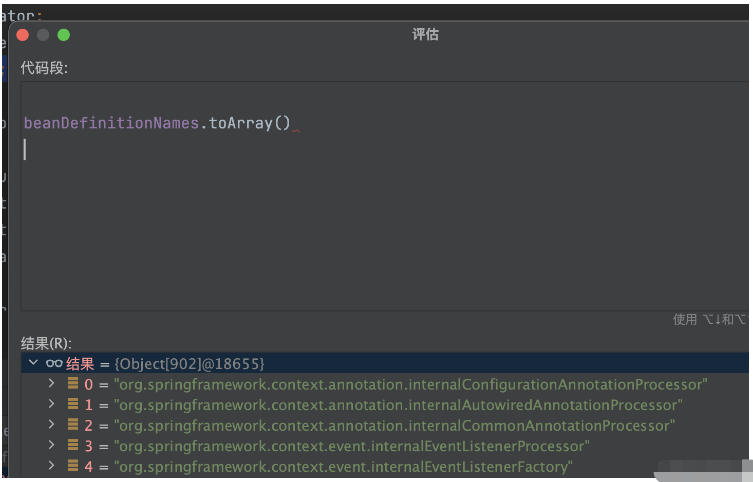您好,登錄后才能下訂單哦!
您好,登錄后才能下訂單哦!
這篇“SpringBoot bean如何查詢加載順序”文章的知識點大部分人都不太理解,所以小編給大家總結了以下內容,內容詳細,步驟清晰,具有一定的借鑒價值,希望大家閱讀完這篇文章能有所收獲,下面我們一起來看看這篇“SpringBoot bean如何查詢加載順序”文章吧。
SpringBoot bean 加載順序如何查看,想看加載了哪些bean, 這些bean的加載順序是什么?
實際加載順序不受控制,但會有一些大的原則:
1、按照字母順序加載(同一文件夾下按照字母數序;不同文件夾下,先按照文件夾命名的字母順序加載)
2、不同的bean聲明方式不同的加載時機,順序總結:@ComponentScan > @Import > @Bean
這里的ComponentScan指@ComponentScan及其子注解,Bean指的是@configuration + @bean
同時需要注意的是:
(1)Component及其子注解申明的bean是按照字母順序加載的
(2)@configuration + @bean是按照定義的順序依次加載的
(3)@import的順序,就是bean的加載順序
(4)在xml中,通過<bean id="">方式聲明的bean也是按照代碼的編寫順序依次加載的
(5)同一類中加載順序:Constructor >> @Autowired >> @PostConstruct >> @Bean
(6)同一類中加載順序:靜態變量 / 靜態代碼塊 >> 構造代碼塊 >> 構造方法(需要特別注意的是靜態代碼塊的執行并不是優先所有的bean加載,只是在同一個類中,靜態代碼塊優先加載)
入口:
public class TestApplication {
public static void main(String[] args) {
try {
SpringApplication.run(TestApplication.class, args);
LOGGER.info("SpringBoot Application Start!!!");
} catch (Throwable e) {
throw e;
}
}
}其中 里面的run方法為:
public ConfigurableApplicationContext run(String... args) {
long startTime = System.nanoTime();
DefaultBootstrapContext bootstrapContext = createBootstrapContext();
ConfigurableApplicationContext context = null;
configureHeadlessProperty();
SpringApplicationRunListeners listeners = getRunListeners(args);
listeners.starting(bootstrapContext, this.mainApplicationClass);
try {
ApplicationArguments applicationArguments = new DefaultApplicationArguments(args);
ConfigurableEnvironment environment = prepareEnvironment(listeners, bootstrapContext, applicationArguments);
configureIgnoreBeanInfo(environment);
Banner printedBanner = printBanner(environment);
context = createApplicationContext();
context.setApplicationStartup(this.applicationStartup);
prepareContext(bootstrapContext, context, environment, listeners, applicationArguments, printedBanner);
**refreshContext**(context);
afterRefresh(context, applicationArguments);
Duration timeTakenToStartup = Duration.ofNanos(System.nanoTime() - startTime);
if (this.logStartupInfo) {
new StartupInfoLogger(this.mainApplicationClass).logStarted(getApplicationLog(), timeTakenToStartup);
}
listeners.started(context, timeTakenToStartup);
callRunners(context, applicationArguments);
}
catch (Throwable ex) {
handleRunFailure(context, ex, listeners);
throw new IllegalStateException(ex);
}
try {
Duration timeTakenToReady = Duration.ofNanos(System.nanoTime() - startTime);
listeners.ready(context, timeTakenToReady);
}
catch (Throwable ex) {
handleRunFailure(context, ex, null);
throw new IllegalStateException(ex);
}
return context;
}refreshContext(context);
private void refreshContext(ConfigurableApplicationContext context) {
if (this.registerShutdownHook) {
shutdownHook.registerApplicationContext(context);
}
**refresh**(context);
}AbstractApplicationContext#refresh
然后看倒數第二行:finishBeanFactoryInitialization(beanFactory);
org.springframework.context.support.AbstractApplicationContext#refresh
@Override
public void refresh() throws BeansException, IllegalStateException {
synchronized (this.startupShutdownMonitor) {
StartupStep contextRefresh = this.applicationStartup.start("spring.context.refresh");
// Prepare this context for refreshing.
prepareRefresh();
// Tell the subclass to refresh the internal bean factory.
ConfigurableListableBeanFactory beanFactory = obtainFreshBeanFactory();
// Prepare the bean factory for use in this context.
prepareBeanFactory(beanFactory);
// Allows post-processing of the bean factory in context subclasses.
postProcessBeanFactory(beanFactory);
StartupStep beanPostProcess = this.applicationStartup.start("spring.context.beans.post-process");
// Invoke factory processors registered as beans in the context.
invokeBeanFactoryPostProcessors(beanFactory);
// Register bean processors that intercept bean creation.
registerBeanPostProcessors(beanFactory);
beanPostProcess.end();
// Initialize message source for this context.
initMessageSource();
// Initialize event multicaster for this context.
initApplicationEventMulticaster();
// Initialize other special beans in specific context subclasses.
onRefresh();
// Check for listener beans and register them.
registerListeners();
// Instantiate all remaining (non-lazy-init) singletons.
**finishBeanFactoryInitialization(beanFactory);**
// Last step: publish corresponding event.
finishRefresh();
}finishBeanFactoryInitialization(beanFactory)
然后看最后一行:beanFactory.preInstantiateSingletons();
protected void finishBeanFactoryInitialization(ConfigurableListableBeanFactory beanFactory) {
// Initialize conversion service for this context.
if (beanFactory.containsBean(CONVERSION_SERVICE_BEAN_NAME) &&
beanFactory.isTypeMatch(CONVERSION_SERVICE_BEAN_NAME, ConversionService.class)) {
beanFactory.setConversionService(
beanFactory.getBean(CONVERSION_SERVICE_BEAN_NAME, ConversionService.class));
}
// Register a default embedded value resolver if no BeanFactoryPostProcessor
// (such as a PropertySourcesPlaceholderConfigurer bean) registered any before:
// at this point, primarily for resolution in annotation attribute values.
if (!beanFactory.hasEmbeddedValueResolver()) {
beanFactory.addEmbeddedValueResolver(strVal -> getEnvironment().resolvePlaceholders(strVal));
}
// Initialize LoadTimeWeaverAware beans early to allow for registering their transformers early.
String[] weaverAwareNames = beanFactory.getBeanNamesForType(LoadTimeWeaverAware.class, false, false);
for (String weaverAwareName : weaverAwareNames) {
getBean(weaverAwareName);
}
// Stop using the temporary ClassLoader for type matching.
beanFactory.setTempClassLoader(null);
// Allow for caching all bean definition metadata, not expecting further changes.
beanFactory.freezeConfiguration();
// Instantiate all remaining (non-lazy-init) singletons.
**beanFactory.preInstantiateSingletons();**
}beanFactory.preInstantiateSingletons()
在這里會對 beanDefinitionNames 進行遍歷,然后進行 bean的實例化 和 組裝
因此這里的 beanDefinitionNames 這個列表決定了bean 的 注冊順序。
org.springframework.beans.factory.support.DefaultListableBeanFactory#preInstantiateSingletons
@Override
public void preInstantiateSingletons() throws BeansException {
if (logger.isTraceEnabled()) {
logger.trace("Pre-instantiating singletons in " + this);
}
// Iterate over a copy to allow for init methods which in turn register new bean definitions.
// While this may not be part of the regular factory bootstrap, it does otherwise work fine.
**List<String> beanNames = new ArrayList<>(this.beanDefinitionNames);**
// Trigger initialization of all non-lazy singleton beans...
for (String beanName : beanNames) {
RootBeanDefinition bd = getMergedLocalBeanDefinition(beanName);
if (!bd.isAbstract() && bd.isSingleton() && !bd.isLazyInit()) {
if (isFactoryBean(beanName)) {
Object bean = getBean(FACTORY_BEAN_PREFIX + beanName);
if (bean instanceof FactoryBean) {
FactoryBean<?> factory = (FactoryBean<?>) bean;
boolean isEagerInit;
if (System.getSecurityManager() != null && factory instanceof SmartFactoryBean) {
isEagerInit = AccessController.doPrivileged(
(PrivilegedAction<Boolean>) ((SmartFactoryBean<?>) factory)::isEagerInit,
getAccessControlContext());
}
else {
isEagerInit = (factory instanceof SmartFactoryBean &&
((SmartFactoryBean<?>) factory).isEagerInit());
}
if (isEagerInit) {
getBean(beanName);
}
}
}
else {
getBean(beanName);
}
}
}
// Trigger post-initialization callback for all applicable beans...
for (String beanName : beanNames) {
Object singletonInstance = getSingleton(beanName);
if (singletonInstance instanceof SmartInitializingSingleton) {
StartupStep smartInitialize = this.getApplicationStartup().start("spring.beans.smart-initialize")
.tag("beanName", beanName);
SmartInitializingSingleton smartSingleton = (SmartInitializingSingleton) singletonInstance;
if (System.getSecurityManager() != null) {
AccessController.doPrivileged((PrivilegedAction<Object>) () -> {
smartSingleton.afterSingletonsInstantiated();
return null;
}, getAccessControlContext());
}
else {
smartSingleton.afterSingletonsInstantiated();
}
smartInitialize.end();
}
}
}
如果不能看,像圖中一樣,不能找到java.util.list這個類,可以使用下面這個方式,親測有效:
beanDefinitionNames.toArray()

后面的bean就不展示順序了。感興趣的讀者可以看自己springBoot項目的。
beanDefinitionNames 列表如何來的呢?
答案是 ConfigurationClassPostProcessor 通過掃描 代碼+注解生成的,講bean 掃描解析成 beanDefinition, 同時把 bean定義,beanDefinition,注冊到 BeanDefinitionRegistry, 故有了beanDefinitionNames list。
以上就是關于“SpringBoot bean如何查詢加載順序”這篇文章的內容,相信大家都有了一定的了解,希望小編分享的內容對大家有幫助,若想了解更多相關的知識內容,請關注億速云行業資訊頻道。
免責聲明:本站發布的內容(圖片、視頻和文字)以原創、轉載和分享為主,文章觀點不代表本網站立場,如果涉及侵權請聯系站長郵箱:is@yisu.com進行舉報,并提供相關證據,一經查實,將立刻刪除涉嫌侵權內容。